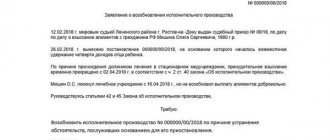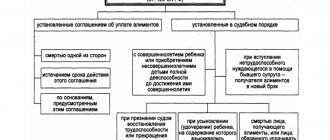Reasons for revocation
In accordance with current legislation, the plaintiff, if he wins the lawsuit, has the right to receive a writ of execution, on the basis of which forced collection of the debt is carried out. A court order or a notarized agreement can also serve as an executive document.
Any person who submitted it for forced execution has the right to revoke a writ of execution or a document replacing it. In essence, this procedure entails the suspension of collection of payments, but does not deprive the creditor of the right to resubmit the document.
The most common reasons for revoking a sheet are the following circumstances:
- resumption of family relationships. Despite the fact that the law does not prohibit the collection of alimony during an existing marriage, in practice this is rarely used. Most often, after resumption of family life, spouses decide to suspend alimony payments, since the obligation to support children begins to be fulfilled voluntarily;
- the parent living with the child and actually recognized as the recipient of alimony payments does not consider it necessary to receive amounts from the second parent, since either he himself has the necessary income or does not want to depend on another person. A purely psychological factor based on personal views and preferences;
- the parties agreed on a different procedure for providing for the child, for example, housing was provided at a time and vital items and products are regularly provided;
- a different agreement has been reached between the parties, for example, the payer is unable to pay the full amount due to personal problems and the parties decide to change the amount voluntarily. Ideally, the procedure should be implemented through the court, but in practice, quite often the collection is simply suspended, and the debtor begins to fulfill the obligation on his own.
This is not an exhaustive list of reasons, but the most common. In practice, other situations are possible.
Validity
The writ of execution for alimony terminates upon the occurrence of the following circumstances:
- The child for whom the funds were collected has reached 18 years of age.
- The payer has died.
- The child is emancipated (acquired legal capacity before the age of 18, for example, got married or works under an employment contract).
- The baby was adopted.
- Death of a child.
Important! It may be difficult to present a document to bailiffs if it was issued more than 3 years ago. However, this is not a basis for re-filing the claim. You can file a complaint against such actions by officials with the prosecutor's office.
The procedure for revoking a writ of execution
The possibility of returning a writ of execution to a claimant is regulated in Article 46 of the Federal Law “On Enforcement Proceedings”. Paragraph 1 states that a refund can be implemented in case of partial recovery or in cases where the recovery has not yet been made at all, at the request of the person.
Attention! Paragraph 4 of the same article states that the withdrawal of the sheet cannot become a reason for refusing to re-accept the document for execution.
On the one hand, it is simply impossible to refuse child support payments. The state protects the rights of minors, therefore no agreements between persons can be accepted if they violate the rights of citizens in whose favor alimony is paid.
Application for withdrawal of a writ of execution
In practice, there is an opportunity to stop payments - the recipient submits an application to revoke the sheet. You can do this in the following order:
- Prepare an application for revocation of the writ of execution. There are no special requirements for the content and form of the document; the main thing is to correctly indicate all the necessary details.
- Submit an application to the appropriate department of the bailiff service.
- Receive a sheet (or court order) and a resolution.
The application must be submitted either to the head of the relevant department, or to the bailiff who is in charge of the relevant case.
The document contains the following information:
- details of the SSP department, as well as the bailiff to whose name the application is being submitted;
- applicant's details;
- an indication of the fact of initiation of enforcement proceedings, details of the case;
- the reason why the sheet is being recalled;
- request for the return of the sheet.
At the end of the paper a signature is placed, as well as the date of the application.
If alimony is collected through the employer
In a situation where the writ of execution was submitted directly to the employer to collect funds from wages, withdrawal of the writ of execution is also possible. The proceedings, in fact, are not with the bailiffs, but in the accounting department at the place of employment of the debtor.
In this case, it is also possible to revoke the sheet. The procedure will be approximately the same as when revoking a sheet from the SSP, that is, an application is drawn up, submitted to the appropriate department and the sheet is returned to the claimant.
How to revoke
It is necessary to distinguish between the revocation and cancellation of a writ of execution. The revocation is carried out at the initiative of the claimant. To cancel the writ of execution for alimony, the payer must contact the court. The interested party must prove the existence of grounds for revocation. For example, the child now lives permanently with his father. If he wants to cancel the writ of execution, he can additionally ask the court to exempt him from paying the debt.
The claimant may have the following reasons to revoke the writ of execution for alimony:
- The parties came to a voluntary agreement.
- A conflict arose between the parents over money.
- Monthly payments have been replaced by a lump sum.
- A non-property agreement has been concluded between the parties.
The conclusion of a voluntary agreement is possible at any stage until the child reaches 18 years of age. The presence of a writ of execution is not an obstacle to this. The agreement is a promissory note certified by a notary. In addition, in case of non-fulfillment, the claimant can return the document to forced retention.
Although child support is the responsibility of parents, enshrined in law, fathers often provoke conflicts based on the collection of alimony. Therefore, mom has to revoke the writ of execution.
If the parties agree, it is possible to replace monthly payments with a one-time transfer to the child of a large amount of money or property (apartment, house, car).
The defendant can manipulate parental rights to force the writ of execution to be revoked. This behavior is not legal, but is common in practice. For example, the father refuses to give consent to the sale of property belonging to the child, or to travel abroad of the Russian Federation.
Important! A change of place of residence of the claimant is not grounds for revoking the writ of execution. It is enough to provide this information to the bailiff in writing.
Consequences of the recall
It is possible to revoke a writ of execution from the bailiff service or from the debtor’s employer; the procedure is simple and clear and does not require special actions. But each person implementing it must be aware of the consequences of such a recall.
After the revocation of the writ of execution for alimony:
- proceedings are terminated until the document is returned for execution. Each recipient has this right, before appealing the decision to collect alimony in court;
- accrual of debt and penalties also ceases. However, this does not mean that for the period when the sheet was not executed, the debt cannot be accrued at all. It will be necessary to prove through the court the fact that during the period when the sheet was not in execution, the second parent did not fulfill his duties.
The writ of execution can be returned to the bailiff service or place of work at any time before the child becomes an adult. There is an opinion that child support may be calculated for longer if the child is a full-time student, up to 21 years of age. But that's not true. The law does not contain this condition.
It is important to understand that revoking the sheet does not mean a waiver of alimony. Refusal is impossible at all, since if we are talking about alimony for children, then refusal may violate their legal rights and interests, which is contrary to the policy of the state in general and the Guardianship and Trusteeship Authorities in particular.
Another important point. If there is arrears in alimony payments, withdrawal of the sheet will not mean its cancellation. However, after the revocation and until the subsequent return of the document for execution, enforcement measures will not be applied to the debtor, but after the return of the sheet for execution, the measures will be resumed.
Arbitrage practice
In practice, disputes regarding the revocation of executive documents arise quite often. Most often, the essence of the conflict is that the debtor is trying to collect the debt for the period when the sheet was not executed, and the debtor objects, pointing out the fulfillment of his obligations.
Debt can only be collected for a period not exceeding three years before the re-submission of the writ of execution.
In practice, courts often side with the creditor, since debtors rarely provide evidence of the fulfillment of their obligations. If such evidence is provided (receipts, bank statements on transfers), then the requirements will be denied.
The Constitutional Court also clarified some other points. Thus, previously, the writ of execution could be returned and resubmitted an unlimited number of times. The court took note of this and decided that such behavior could be considered unconscionable for two reasons:
- The debtor is constantly in a state of ignorance, does not know exactly whether coercive measures will be applied to him or not.
- The debtor often does not have the opportunity to voluntarily sell his property in order to independently pay off the existing debt.
As a result, the court decided that the periods during which the debt was not collected, since the sheet was withdrawn, cannot exceed more than three years in total. Otherwise, the debt will not be collected for a longer period.
Revocation of alimony sheet for adult citizens
In accordance with the Family Code of the Russian Federation, alimony can be collected not only for children, but also for:
- spouses and former spouses who became disabled during marriage;
- parents who have become unable to work, including those who have reached retirement age, if their own funds are not enough to meet life’s needs;
- adults but disabled children;
- spouse during pregnancy, as well as during the period three years after childbirth.
The main requirement for collecting alimony in such situations is the need for additional support.
The collection procedure is carried out in the same way as when collecting alimony for minor children. Accordingly, the revocation of a writ of execution is also implemented in the same way - the applicant applies to the FSSP, receives a writ of execution, and then has the opportunity to return the document at any time for execution.
Application for initiation of enforcement proceedings for payment of alimony
The document is drawn up in writing, by hand or on a computer. It is recommended to use the second method, since if there are a large number of errors, the form will be sent back. It states:
- The name of the FSSP department, the details of the claimant in the upper right corner.
- The name of the document is in the center in large letters.
- Request for acceptance of a writ of execution with the number and name of the case.
- Data of the debtor with place of residence or stay, current telephone number, place of work.
- It is clarified that no proceedings have been started in this case before. If it was initiated, indicate the date of the process, reasons for suspension, termination, list compulsory actions, the amount of money transferred, property.
- If there is additional information about the other party, write it in the paragraph below.
- To ensure the implementation of the decision, indicate the need to seize the defendant’s property (write about existing assets), add that there is a possibility of concealing property in order to avoid liability.
- In the next line, indicate Article 30 of the law regulating enforcement proceedings and write the word “please”. It is recommended to list the requirements in a list. The main thing is to excite the process.
- Indicate the phrase “please transfer funds” and add the bank account number to which alimony will be transferred. Provide information right away to avoid delays later.
- The next part is applications. Submit the writ of execution in the original, documents confirming the property and financial status of the defendant.
- The date and signature are written at the bottom.
The document is sent to the bailiff by regular or e-mail, or transferred to the office of the FSSP department during the established reception hours. Fill out the form carefully, without colloquial, abusive, or colloquial expressions. In the information column, indicate only reliable information about the debtor, which will help in the search for property, its arrest and sale.
The decision to begin the enforcement procedure is issued within three days from the date of receipt of the official paper.











